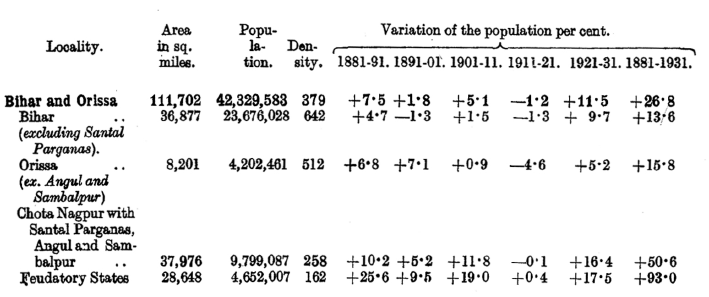Census India 1931: The Population Problem in Bihar and Orissa
This article is an extract from CENSUS OF INDIA, 1931 Report by J. H. HUTTON, C.I.E., D.Sc., F.A.S.B., Corresponding Member of the Anthropologische Gesselschaft of Vienna. Delhi: Manager of Publications 1933 (Hutton was the Census Commissioner for India) Indpaedia is an archive. It neither agrees nor disagrees |
Census India 1931: The Population Problem in Bihar and Orissa
Bihar and Orissa has a heterogeneous population of 42,329,583 in an area of 111,702 sq. miles giving a mean density of 379 per sq. mile, of which 28,648 sq. miles consist of feudatory States which contain more than 4i millions of the population. The increase of the province has been 11.5 per cent. since 1921.
The population falls naturally into three areas which do not correspond to its administrative divisions, that is into Bihar (exclusive of the Santal Parganas), the Chota Nagpur plateau together with the Santal Parganas and the Feudatory States, and Orissa proper. The mean density gives little indication of its great variation, which is as high as 969 persons per sq. mile in the Muzaffarpur district of Bihar, with a density of 1,073 if calculated on cultivatable area, and as low as 43 in the Feudatory State of Rairakhol. In previous decades the number Of emigrants has very greatly exceeded the number of immigrants. This excess has been considerably reduced during the past ten years.
But these conditions have been confined to British territory, for in the States there has been in the past an excess of immigrants over emigrants which has been similarly reduced during the past decade. The public health has been exceptionally good throughout the decade, mortality from plague having decreased by about 73 per cent.and from cholera by about 30 per cent. At the same time, though the birth rate has fallen from 41 per mile to 36-5, the survival rate has more than doubled.
Earners profited by a general decline in the cost of living, while cultivators also benefited during the greater part of the decade not only by a succession of good harvests but by the fact that the prices of food grains retained a high level after other prices had fallen. There have been heavy investments in post office 5-year cash certificates ; in the Post Office Savings Bank the number of depositors has risen since 1921 by -27 8 per cent. and the value of the deposits by 102 per cent. The standard of comfort has everywhere risen among the labouring classes, while an outstanding change in diet is the development of tea-drinking.
It has already been pointed out that the population of this province is heterogeneous. That of Bihar is not markedly dissimilar to the population of the east of the United Provinces on the one hand or the west of Bengal on the other, between the populations of which it forms a natural link, and may be regarded as normal Hindustani speaking population of the Ganges valley. In Orissa proper the population is more nearly allied to that of Lower Bengal, but has a distinctive culture of its own. The Chota Nagpur Plateau and the Santal Parganas are primarily the habitat of comparatively primitive Munda speaking tribes and of others speaking Dravidian languages but closely allied to them in race.
Sambalpur and Angul are not dissimilar and the inhabitants of the Feudatory States are also of the same kind, though Oriya replaces Hindi on the southern slopes of the plateau as the medium of communication with the more civilised world.
